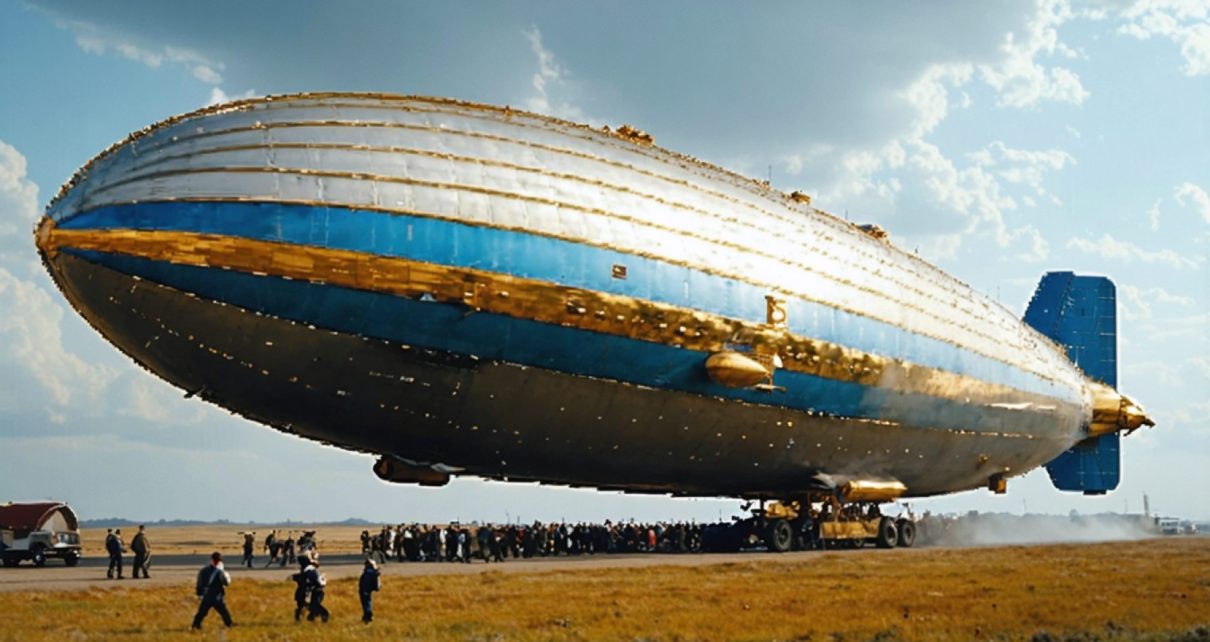- Human history is deeply connected to the evolution of transportation, reflecting ambitions and desires.
- Extravagant gifts, such as private jets, echo historical practices of using opulent travel as political and diplomatic tools.
- The Zeppelin’s rise and fall illustrate the transition from war machines to luxury, ending in a cautionary tale.
- The Siracusia, a massive ancient ship, embodied maritime grandeur and the fading glory of civilizations.
- The Spanish conquistadors’ voyages caused profound impacts, transporting not just wealth but also diseases.
- Travel can be perilous on personal levels, as shown by Rafael Sánchez Mazas’ wartime escape and survival.
- Transportation stories reflect our continuous pursuit of progress alongside the inherent risks and historical legacies.
The chronicle of human civilization is intimately tied to the evolution of how we move—and why. From ancient vessels that carried conquerors across uncharted seas to the airships that promised luxury beyond the clouds, this story traverses the ambitions and desires that have driven humanity’s perpetual motion.
When Qatar lavishes a former U.S. president with a sumptuous Boeing, the gesture echoes the long tradition of extravagant gifts marking milestones of power and diplomacy. This latest offering joins the ranks of some of the priciest tokens in history, yet it barely scratches the surface of our fascination with opulent travel.
Consider the brief, tumultuous life of the Zeppelin. Once hailed as the future of airborne transport, these colossal dirigibles sowed terror in the skies above Britain during the First World War. Their promise quickly shifted from warfare to opulence, as they became floating palaces for the elite. However, the Hindenburg’s fiery demise—and the flaming end it signaled for the Zeppelin—cemented their legacy as a cautionary tale of ambition flying too close to the sun.
History is strewn with such tales of grandeur. Imagine the awe-inspiring Siracusia, launched under the auspices of Hiero of Syracuse. This leviathan of the seas boasted 142 staterooms, a library, a pool, and even thermal baths. It was so vast, it overwhelmed most ports such as its homeland of Syracuse. Ultimately gifted to Ptolemy III in Alexandria, its fate receded into the mists of time, much like the civilization that birthed it.
Centuries later, the age of exploration unfurled new pages in this narrative. The Spanish conquistadors traversed oceans, their ships casting long shadows of influence and devastation. Charles C. Mann reflects on the cataclysmic impact their journeys had in “1493,” a sobering account of new lands meeting old diseases, leading to catastrophic indigenous population losses.
Even on less epic scales, travel held peril and intrigue. Take Rafael Sánchez Mazas, whose flight across war-torn terrain was fraught with the personal stakes of survival rather than imperial conquest.
The ceaseless march of transportation, in its splendor and ruin, underscores a simple truth: the ways we choose to move reveal the contours of our desires and the shadows of our missteps. These stories invite us to consider the vehicles not just as machines, but as emblems of our enduring quest for progress—and the peril that often accompanies it.
The Opulent and Dangerous History of Travel: A Closer Look at Humanity’s Transportation Evolution
Introduction: The Allure of Opulent Travel
The journey of human civilization has been significantly shaped by the evolution of transportation. From luxurious airships to grand seafaring vessels, the history of travel is rich with tales of ambition and extravagance. This narrative continues today with modern gifts, like Qatar’s Boeing bestowed upon a former U.S. president, echoing the opulence of the past.
The Rise and Fall of the Zeppelin
Historical Context:
The Zeppelin, at the height of its existence, was not only a marvel of engineering but also a symbol of luxury and status. These colossal airships were initially developed for military use during World War I, seeding fear and terror in the skies of Europe. However, after the war, Zeppelins transitioned into a luxurious mode of air travel for the elite, promising a level of comfort and opulence unmatched at the time.
The Hindenburg Disaster:
One of the most infamous moments in aviation history is the Hindenburg disaster of 1937, which dramatically ended the era of the Zeppelin. The catastrophic fire that engulfed the Hindenburg during its docking in New Jersey marked a turning point in public perception, pivoting from fascination to fear regarding airship travel.
Modern-day Air Travel:
While modern aviation has eclipsed the grandeur of Zeppelins in terms of speed and safety, luxury private jets like those from Qatar offer a glimpse of the opulence once experienced. Featuring custom interiors, state-of-the-art technology, and unparalleled service, these jets are modern heirs to the grand tradition of luxury travel.
Magnificent Vessels of the Past
The Siracusia Example:
The Siracusia, a formidable ancient Greek ship, was a floating palace complete with staterooms, a library, and swimming facilities. Its construction under Hiero of Syracuse and eventual gifting to Ptolemy III exemplify the use of grand vessels as diplomatic tokens and statements of power.
Legacy of Exploration:
During the Age of Exploration, ships became vessels of conquest and change. The Spanish conquistadors used them to traverse oceans, carving out colonies and altering the course of history. Charles C. Mann’s “1493” offers a detailed exploration of these voyages’ profound impacts, including the transmission of diseases that drastically reduced indigenous populations.
The Ongoing Evolution of Transportation
The Global Impact of Transport Evolution:
With each advancement in transportation technology, there comes both opportunity and peril. This dual nature reflects in contemporary discussions about sustainable travel and the environmental impact of our choices.
Emerging Trends:
The future of travel seems poised for another transformation with the advent of electric and autonomous vehicles. Industry trends suggest an impending shift toward more sustainable and efficient travel solutions with companies heavily investing in green technologies.
Considerations for Sustainable Travel:
For those interested in sustainable travel, consider reducing the carbon footprint by choosing efficient travel routes, using public transportation, or opting for eco-friendly vehicles.
Conclusion: Actionable Tips and Key Takeaways
To embrace the lessons from history and the present, consider the following tips:
– Eco-Conscious Decisions: Engage in sustainable travel practices whenever possible to mitigate environmental impacts.
– Stay Informed: Keep abreast of technological advancements in transportation for a more efficient and cost-effective travel experience.
– Reflect on History: Understand the historical context of travel modes to appreciate modern conveniences and their societal impacts.
Related Links
For further reading on transportation and travel history, visit [Google](https://www.google.com).
The chronicles of past and present travel illustrate how vehicles are more than mere machines—they are extensions of our desires, imprints of our advancements, and sometimes, reminders of our missteps.



